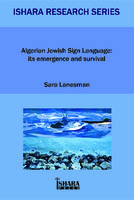Algerian Jewish Sign language: its emergence and survival
Abstract
"This book is concerned with Algerian Jewish Sign Language (AJSL) and the Algerian Jewish Sign Language community. AJSL developed naturally in the Jewish quarter of Ghardaia, a town in the sub-Saharan part of Algeria. A high percentage of deaf people lived in this quarter, and because of that a sign language emerged, and was used by both deaf and hearing members of the community. Many members of the AJSL community migrated to Israel in the middle of the twentieth century, where they have continued to use AJSL with friends and family members. As a result, AJSL has persisted alongside the dominant sign language of Israel, which is Israeli Sign Language (ISL). AJSL is unique as a sign language that has persisted in Israel, alongside a widely used sign language, where the sign languages of other immigrant communities have long since disappeared. The case is made for the importance of documenting AJSL; language documentation is crucial, given that AJSL is now used only by older generations, and no longer acquired by younger generations."
Keywords
algeria; israel; language documentation; language endangerment; algerian jewish sign language; Deaf culture; Ghardaïa; Hearing loss; History of the Jews in AlgeriaDOI
10.26530/OAPEN_588714ISBN
9780992922108OCN
1030818400Publisher
Ishara PressPublication date and place
Lancaster, U.K., 2016Series
Ishara Research Series, 2Classification
Sign languages, Braille and other linguistic communication


 Download
Download Web Shop
Web Shop